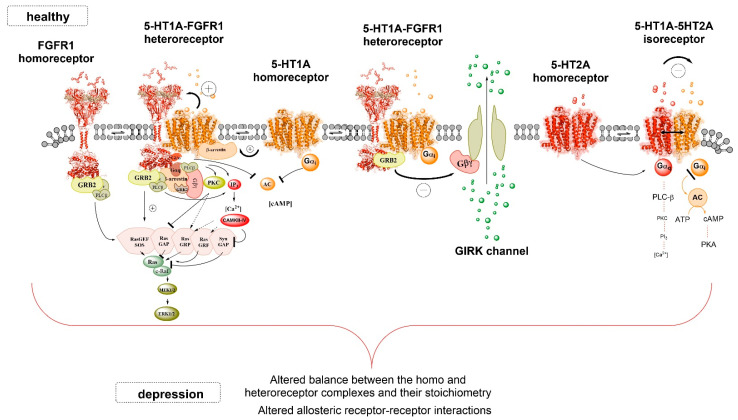Figure 1.
The 5-HT1A-FGFR1 heteroreceptor complexes (to the left) and the 5-HT1A-5-HT2A isoreceptor (to the right) heteroreceptor complexes are illustrated. The term isoreceptor is used for the 5-HT1A-5-HT2A heteromer since the two types of 5-HT receptors are activated by the same transmitter (5-HT). They are in the plasma membrane of control rats (healthy). They are shown to be in balance with the corresponding homoreceptor complexes in the plasma membrane. The FGFR1 homoreceptor complex is presented as a dimer and this is also true also for the 5-HT1A and 5-HT2A homoreceptor complexes. The FGFR1 homoreceptor and the FGFR1 protomer in the heteroreceptor couple are all coupled to ERK1/2, a major signaling pathway for plasticity, via growth factor receptor-bound protein 2 (adaptor protein) and RAS protein. With a curved arrow and plus sign close to it, the allosteric enhancement by the 5-HT1A protomer of the FGFR1 protomer signaling over the GRB2-RAS-ERK1/2 signaling pathway is illustrated. The 5-HT1A receptor protomer is presented as a dimer. As a result, the FGFR1 activation by an FGFR1 agonist is increased, leading to enhanced neuroplasticity involving the ERC1/2 pathway [16]. The 5-HT1A protomer in the heteroreceptor complex mainly signals via Gi/o to inhibit AC activity, like the 5-HT1A homoreceptor, as indicated. The other 5-HT1A-FGFR1 heteromer instead is used to illustrate how the FGFR1 protomer linked to GRB2 upon activation can reduce the coupling of the 5-HT1A protomer to the GIRK channel via an inhibitory allosteric interaction in the heterocomplex. The detailed molecular mechanism is unknown, but the result is an allosteric brake of the 5-HT1AR-induced opening of the GIRK channels. In the dorsal raphe, it leads to an inability of the 5-HT1A auto-receptor to hyperpolarize the dorsal raphe neurons and an increased firing of the dorsal raphe serotonin neurons can develop, leading to antidepressant actions. In the right part of the figure, the 5-HT1A-5-HT2A heteromer is shown as a heterodimer. It is illustrated that the 5-HT2A protomer via an inhibitory allosteric receptor–receptor interaction can reduce its signaling over the Gi/o-AC-PKA pathway. This leads to a dominance of 5-HT2A signaling with depressive effects [20]. The figure especially illustrates how allosteric inhibitory or facilitatory allosteric receptor–receptor interactions among the receptor protomer of the complex can produce antidepressant or depressive events which can help determine if antidepressant or depressive effects develop.

